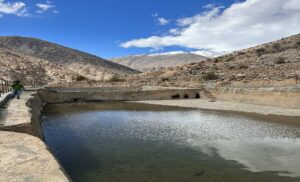Shifting to use of renewable sources like the solar power in a region with abundant natural resources, will not only enhance livelihoods but also reduce costs on fossil fuels. Environmental benefits of using solar energy are huge. The case of Ladakh shows the way.
Ladakh is one of the world’s coldest and most elevated inhabited regions. The region is blessed with abundant natural resources like sunlight. The area receives more than 320 clear sunny days in a year and annual solar radiation of 2149kWh/m2, with the mean ambient temperature rarely exceeding 27 degrees Celsius. All these conditions make the region ideal for solar energy generation, especially in terms of photovoltaic and thermal power.

Shingo Nalla River, the only spring water source for the region
Latoo is the last village on the Indian border, situated in Ladakh. It was inhabited by refugees in 1967. The village has sufficient cultivable land but the mainstream from which irrigation water comes is in Pakistan. The area is situated at a height of 700 feet above the Shingo Nalla River. The only water source for the region is the spring water, lifted electric or diesel-based water pump sets. Excessive use of spring water along with increasing environmental pollution and climate change, has resulted in water scarcity. Also, the use of electric or diesel-based pumps to lift water from the river has led to huge electricity bills. In such a background, the Ladakh Autonomous Hill Development Council Kargil (LAHDC) and Kargil Renewable Energy Development Agency (KREDA) together started a model project of water lifting system using solar submersible water pump.
The initiative
In the project area, around 23 acres of land with apricot trees, alpha-alpha, kitchen gardens, etc., is facing drought. Roughly 15 acres of land, is cultivable but left uncultivated. This uncultivated area will be cultivated using the solar water pump, which can lift water for irrigation without any extra cost and adverse environmental effects.
A solar water lifting system was installed, to help irrigate the land. The pumping system is an entirely solar-based submersible pump of 41Hp power. The system consists of a solar plant of a capacity 50kWp to run the pumping system. The pump is kept in a jack well of size 3.35m x 2.10m x 3.65m at the river bank, and water is lifted through the delivery pipe of diameter 140mm. The length of the pipe is about 360 meters. The system has a head range of 130-160 meters and will help lift one lakh litres of water in six hours.

Solar water pumps restored cultivation on uncultivated lands
The solar water pump has been working from 2019 till now, during the summer months of April to November. People living in the area are very happy with the working of the system. Farmers are growing fruits and vegetables for their own use and for markets too, leading to better incomes.
In addition to providing irrigation to the uncultivated and drought prone land, the solar water pump has also generated employment. Two people from the village were selected and were given training on maintenance of the pumps. They have been employed on monthly basis to manage the pump. Besides, the company not only sends their team every year for an annual check up, but also services whenever an unforeseen problem arises. The company also provides some spare parts, free of cost, for future need. Presently the pump is working well.
As there is no agriculture production in winter, there is no need for lifting water during winters. But the government, instead of leaving the solar pump idle during winters, planned to use it to achieve its Har Ghar Jal’s vision of Jal Jeevan Abhiyan. Further, it has carried out technical and economic analysis and found the use of solar energy cheaper than any other source of energy. Solar energy will also help the region to move towards carbon neutral pathway.
With the success of this initiative, many more such projects have been commissioned in rural villages of Ladakh, such as Dargo, Santakchan, Adulgund and Chhanigund. In addition to solar water pumps, other solar products like solar water heaters, solar greenhouses, solar pack houses, solar street lighting are also gaining attention in the region. Ladakh’s continued prosperity will depend on the use of renewable energy like the solar power, resulting in enhanced opportunities for income and employment generation, environmental benefits and better standard of living.
References
Lohan, S. K., & Sharma, S., Present status of renewable energy resources in Jammu and Kashmir State of India, 2012, Renewable and Sustainable Energy Reviews, 16(5), 3251–3258. https://doi.org/10.1016/j.rser.2012.02.011
https://pmkusum.mnre.gov.in/pdf/Community%20Irri%20KREDA.pdf
Bilques Fatima
Bilques Fatima
Doctoral Research Scholar, Department of Economic Studies
Central University of Punjab, Bathinda-151401
E-Mail: bilques.fatima93@gmail.com









